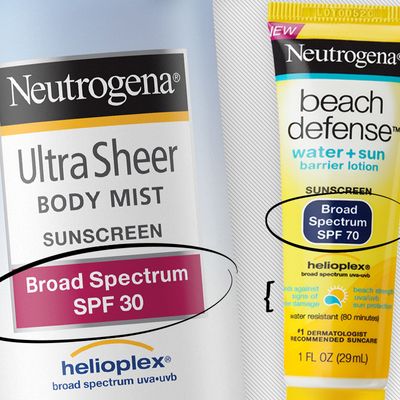
Welcome to sunscreen week at the Cut, where we provide you products reviews, tips, and news you’ll need for better sun safety. But first, here’s this: Protecting your skin from harmful UVA/UVB rays is the best beauty tip. Ever.
Transparency is not just what we want in a sunscreen, it’s what we should look for on the label, too. Starting this summer, the FDA has mandated that sunscreen packaging be straightforward about exactly what’s inside (with the percentage of active ingredients listed on the package) and how much sun protection is provided. Labels for new products in the category (which include lip balms and makeup with sunscreen, such as BB and CC creams) must follow these specific guidelines as well. One note, though: While the majority of sunscreen products on the market should comply with the new testing and labeling requirements, you may see a few outdated labels that were on retail shelves before the regulations were set. (Small-volume manufacturers, including little indie brands, have a compliance date of December 2013 to update their packaging.)
The government is also currently evaluating the effectiveness of those handy sunscreen wipes, body washes, shampoos, and powders. The question remains: Do these SPF gimmicks deliver enough sunscreen onto the skin (or hair) to back up their sun-protection claims? Sprays, which people love for the convenience in application, are also in the FDA’s sights for the same dosage-based reasons, so this may be the last summer you can buy sunscreen in an aerosol can.
“Dermatologists get geeky-happy about this kind of government regulation. It’s a game changer because products have to state how much protection they will give you, and be scientifically tested to back up those claims,” says dermatologist Ellen Marmur of Marmur Medical in NYC. “Skin cancer blows away all other cancers combined, and it’s the most common cancer in the U.S., so this clear-cut labeling is amazingly important for consumers.”
Here’s what to look for:
Broad Spectrum.
“This is the most important thing to check,” Marmur says. “It means the product has been tested and proven to protect against both UVA and UVB radiation.” Old labels only showed an SPF number, which reflects a product’s protection from UVB — the shorter wavelengths that cause sunburn on the surface of the skin. “If a label specifies the SPF (even if it’s a high number) but doesn’t say “broad spectrum” then it’s not necessarily screening your skin from the longer UVA wavelengths.” These are the ones that penetrate deeper and cause skin cancer, brown spots, wrinkling, and, yeah, a tan.
Drug Facts.
The percentage of active ingredients — such as minerals like zinc oxide and titanium dioxide, or chemicals like avobenzone or octinoxate — must now be listed under “Drug Facts” on the container, along with their potency.
The SPF number.
Sun Protection Factor or SPF gauges protection from UVB, and contrary to what many people think, it doesn’t have anything to do with the amount of time you can spend in the sun. It’s determined by a standard FDA test that measures how much UV radiation it takes to burn skin with sunscreen compared to the amount of UV it takes to burn bare skin. (So SPF 30 means that it would take 30 times the amount of UVB radiation to cause sunburn with this sunscreen on.)
The FDA is evaluating whether to put a cap on this number at SPF 50-plus, since anything over 50 doesn’t give you that much more protection. For now, the higher numbers stay on the label, but you should know that the math doesn’t really add up. “While SPF 15 screens up to 95 percent of UVB rays, an SPF 30 filters 97 percent. And most people don’t put on nearly the cake-frosting amount of sunscreen that’s used to test the SPF, ” Marmur explains. Her bottom line: Your daily sunscreen should be somewhere between SPF 30 and 50.
Sun protection measures.
The FDA now requires labels to also include a statement about the danger of sun exposure and to offer additional protection tactics. Here’s what it says:
Spending time in the sun increases your risk of skin cancer and early skin aging. To decrease this risk, regularly use a sunscreen with a broad spectrum SPF 15 or higher and other sun protection measures including:
· Limit time in the sun, especially from 10 a.m.–2 p.m.
· Wear long-sleeve shirts, pants, hats and sunglasses.
· Children under 6 months: Ask a doctor.
A warning sign.
Sunscreens that are not proven to be broad spectrum, or that have an SPF lower than 15, now have to include a scary warning on the label (that looks like those found on cigarette packs). Here’s what it says:
Skin Cancer/Skin Aging Alert: Spending time in the sun increases your risk of skin cancer and early skin aging. This product has been shown only to help prevent sunburn, not skin cancer or early skin aging.
As Marmur explains, “That cocoa tanning oil SPF 8 now has to carry a caution sticker, which is the coolest thing I’ve ever heard. If you don’t get the message that this product isn’t good protection, then you’re obviously not reading the label.”
No more “-Block” or “-Proof.”
You won’t see the misleading words “sunblock,” “waterproof,” or “sweat-proof” anymore. Why? “The only way to truly block the sun is to live in a cave, and sunscreens aren’t proven to be totally waterproof. All of them eventually wear or rinse off.”
New Time Limits.
Products labeled as “water-resistant” must clearly designate how long the SPF protection (from sunburn) lasts in the water — either up to 40 or 80 minutes based on standardized testing. So the label will look something like this: Broad spectrum SPF 30 water resistant (40 minutes).
As Marmur concludes: “Unfortunately most people fail to reapply their sunscreen during the day, but at least this gives you the info right up front.”




